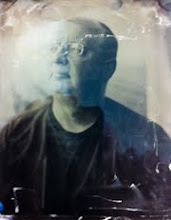Title: "Under the Frozen Sky"
A friend sent me a link to a gallery show in Berkeley of photographs taken with iPhones. The gallery people see iPhone photography as a clear bastion of the "amateur" photographer. Submission for the show was by a website, and the requirements were clearly stated: the photos submitted had to be taken with an iPhone, they could be manipulated using software *on the phone*, but could not be manipulated in any way using Photoshop or other computer-based programs. And this got me to thinking about placing limits on how art is produced.
There are certainly benefits if an artist devises a project with specific parameters in mid. For instance, I decide I want to do a series of drawings. If I place no limits on myself, I can almost guarantee no drawings will be made. How do I start? Will I use pencil, charcoal, pastels, watercolours, on canvas, paper - what kind, what size? A lack of specific parameters tends to diminish the start of the creative process in my experience. Of course, parameters can become even more specific - I will do a series of 10 drawings on aluminum, using a scribe and a ruler, consisting of 60 lines of varying lengths, changing the direction of each subsequent line after the previous one has been drawn. Such specific parameters can be an interesting way to side-step a creative block, or they can be an avenue to an entirely new way of creating.
In photography, there are those who place a specific limitation of visualizing and making the "final image" directly in the camera. Those taking this "straight out of the camera (SOOC)" approach are combining a love for technical expertise with a desire to apply careful compositional skills. While I admire people with that focus, I am somewhat leery when it becomes a creed, or intolerance of those who take a different approach to their photography. There's no moral high-ground to be claimed here, what's important is each individual finding a path that meets their needs and allows them to create the images they feel compelled to make. I find it interesting that the SOOC crowd trace their roots back to Ansel Adams and the f/64 group. Everything about the image is pre-visualized, carefully composed on the ground glass, lens is stopped down for maximum sharpness, exposure of the film is matched to development time to provide a rich tonal range. While all of this is true of Adams' process, the SOOC advocates forget that Adams also said that while the negative is the score, the print is the performance. Adams used a range of darkroom printing skills and techniques to realize the image he had previsualized. It was not all on the negative, it had to be coaxed out with a virtuoso performance in the darkroom.
Tonight I watched Werner Herzog's movie "Encounters at the End of the Earth", a documentary about the people who live and work on Antartica. Some beautiful underwater footage beneath the ice inspired me to take some images of a wax sculpture I have hanging in my studio. My goal was to produce an image that connected to those I had seen in Herzog's film.


No comments:
Post a Comment